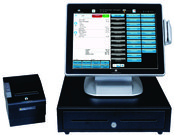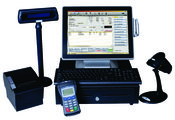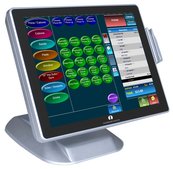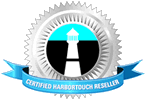All Bakersfield, California and USA restaurant merchants by now should be aware of the IRS Revenue Ruling 2012-18, which went into effect January 2014. For many years the practice of adding automatic tips or gratuities to customer restaurant checks for large parties has been the norm for restaurants and their wait staff. This practice was done to ensure that the wait staff was provided with a pre-set tip amount determined by the restaurant operators. Now, with the IRS ruling, this practice can be an accounting and operational headache for restaurant operators. High quality touchscreen POS systems can provide a solution to operators, while attempting to protect their wait staff’s tips when dealing with large parties.
The California Restaurant Association’s Legal Center published an article written by attorney Alden J. Parker, from Weintraub Tobin. This article along with freepospros.com and Harbortouch’s free touchscreen POS solution can help restaurant operators avoid the complicated and potentially expensive practice of continuing to add automatic tips to large party checks. The article will highlight the new IRS ruling, and we at www.freepospros.com will provide information on why and how a high performance touchscreen POS system can improve a restaurant’s operations, while providing a solution to help wait staff when dealing with large party guest checks.
“In a ruling issued in June 2012 the Internal Revenue Service clarified the difference between a tip and a service charge for tax purposes under the Federal Insurance Contributions Act. The IRS determined automatic gratuities (a percentage automatically added to a restaurant bill) are service charges, rather than tips for tax purposes.
Revenue Ruling 2012-18 also determined that to the extent any portion of a “service charge” is distributed to an employee, it is wages for FICA tax purposes.
So, when is a tip a tip? The ruling provides that an employer’s characterization of a payment as tip is not determinative. Rather, a tip satisfies the following four factors:
- 1. The payment must be made free from compulsion.
- 2. The customer must have the unrestricted right to determine the amount.
- 3. The payment should not be the subject of negotiation or dictated by the employer policy.
- 4. Generally, the customer has the right to determine who receives the payment.
In contrast, when is a tip really a service charge?
The ruling provides the following illustration of an alleged tip that is actually a service charge: A restaurant’s policy of adding an 18 percent service charge to the bill for parties of six or more is a service charge rather than a tip because the customer did not have the unrestricted right to determine the amount of the payment – it was dictated by the restaurant’s policy – and the customer did not make the payment free from compulsion. On the other hand, a bill with sample calculations of different tip amounts, where the actual tip line is left blank, is truly a tip.
How do you ensure a tip is really a tip?
To ensure a tip is not actually a service charge according the IRS, make sure the tip line and total amount on any bill is left blank for the customer to complete in his or her discretion. While a restaurant may include sample calculations on the bill of different tip amounts (e.g., 15% = X), these must be clearly identified for reference purposes only so the IRS does not determine a certain amount is being mandated from the customer.
Why does it matter whether a payment is a tip versus a service charge?
- · Service charges are considered wages, and, therefore, not eligible for the FICA Tip Credit (The 45B Credit). For many years, restaurants have benefited from being allowed to apply a general business credit toward a portion of the employer’s social security and Medicare taxes paid on tips in excess of the federal minimum wage as of Jan. 1, 2007 (i.e., $5.15 per hour).
As the ruling makes clear that service charges are not tips, they cannot be included in the tip amount that social security and Medicare taxes are paid on, which takes some tax credit off the table for restaurants. This credit is claimed on Form(s) 8846 and 3800.
- · Tips and wages are reported on separate lines of the quarterly payroll tax return (Form 941). Incorrectly characterized service charges should be recharacterized and an adjustment made to Form 941 via tax report Form(s) 4666 and 4668.
- · When completing Form 8027 (Employer’s Annual Information Return of Tip Income and Allocated Tips), service charges distributed to employees and the respective sale should not be included on the form.
- · Some business may have to change their automated or manual reporting systems to comply with this distinction.
- · Employers who pay out a portion of the automatic gratuities or service charges to employees may have to recalculate its employees’ overtime rates. The ruling considers these payouts to be wages, rather than tips, so that money counts toward the employee’s regular rate of pay and should be factored into the overtime calculation.
How does this work in practice?
Let’s say an employee works nine hours in one day, and is thus entitled to one hour of overtime pay. If you have paid him a portion of the automatic gratuities he earned that day, that amount counts toward the overall wages he earned that day and must be factored into the calculation of his regular rate of pay (i.e., total wages ÷ 8 hours). In turn, this is the regular rate of pay that would need to be used to determine his overtime pay rate (one-and-a-half times his regular rate of pay) for the one hour of overtime.
If the same employee works more than 40 hours in a week and is paid a portion of the automatic gratuities he earned that week, the amount of automatic gratuities he was paid is considered part of his wages. Accordingly, his total wages for that week, including the automatic gratuity amount, should be divided by 40 hours in order to determine his regular rate of pay. Again, this is the regular rate of pay that must be used to determine his overtime pay for time worked in excess of 40 hours during the week.
Finally, although a service charge on a restaurant bill will most frequently be encountered, restaurants should be cautioned that auto-gratuities paid for catering, banquets, weddings and other amounts mandated by employer policy would likely be covered as well.”
Article provided by The California Restaurant Association’s Legal Center, on March 7, 2013, which was written by Alden J. Parker, attorney / Weintraub Tobin, viewable online at : http://www.calrest.org/newsroom/articles/irs-rules-automatic-gratuities-are-wages-not-tips/?%20-%20comments .
As we have learned from Alden Parker’s article, the effect of adding automatic tips to guest checks will impact restaurant operators’ calculations for both employee wages and taxes for the business.
With a high quality touchscreen POS system, like Harbortouch’s free touchscreen POS solution, available from www.freepospros.com , restaurant operators can more easily calculate wages with built-in time and attendance functions.
Another benefit of the Harbortouch free touchscreen POS solution is the ability to add suggested tip amounts to the bottom portion of the guest check. This will help to protect wait staff from not getting tipped on large parties’ checks, but it is not a guarantee that the guest will tip. The tip amount is left up to the guest, and this complies with the IRS ruling.
The use of suggested tip amounts, with three (3) options already calculated for the guest by the Harbortouch free touchscreen POS system; make it a lot easier for guests when paying the bill. We often choose the middle amount to leave for the server, which most of the time is set at 18 percent of the guest check. The Harbortouch free touchscreen POS solution can have the suggested tip amounts set by the restaurant operators or management, and can be changed anytime from any of our POS systems.
Many of our Casio Electronic Cash Register hospitality merchants will be moving over to our free touchscreen POS program, due to the ease of setting up the suggested tip amounts, as well as the built-in time and attendance functions of our touchscreen POS solutions.
For more information on our revolutionary Harbortouch free touchscreen POS solution, now in our fifth year serving merchants all over California, the USA, Alaska, and Hawaii, please visit us online at www.freepospros.com , or email info@freepospros.com , or call us toll-free at: 1-888-834-2561 Ext. 101.
Thank you.
Keith Ragan and the www.freepospros.com team.
Note: Please consult with your accountant and/or your attorney in your area, to ensure that you are in compliance with the new IRS Ruling mentioned above.





